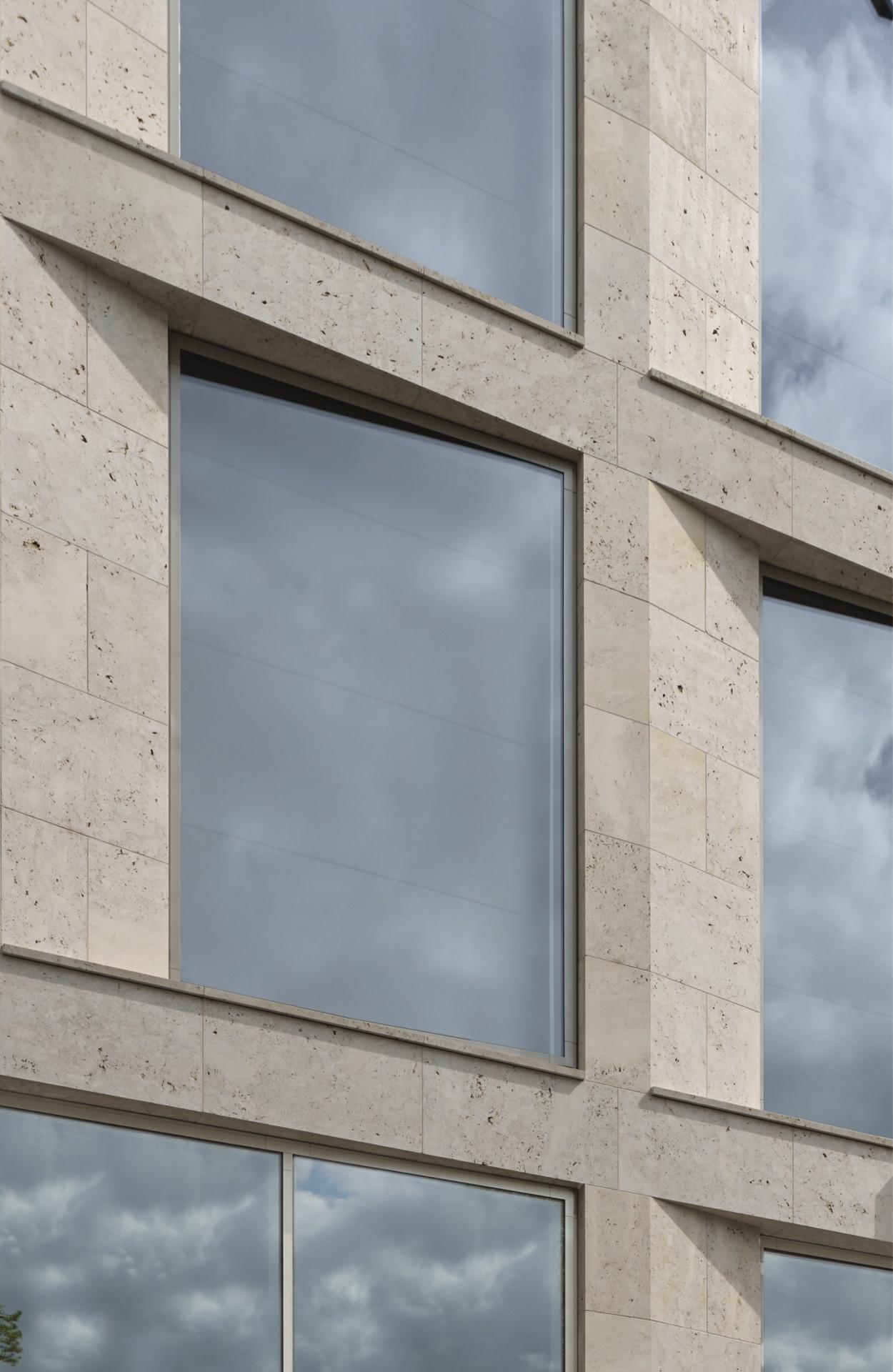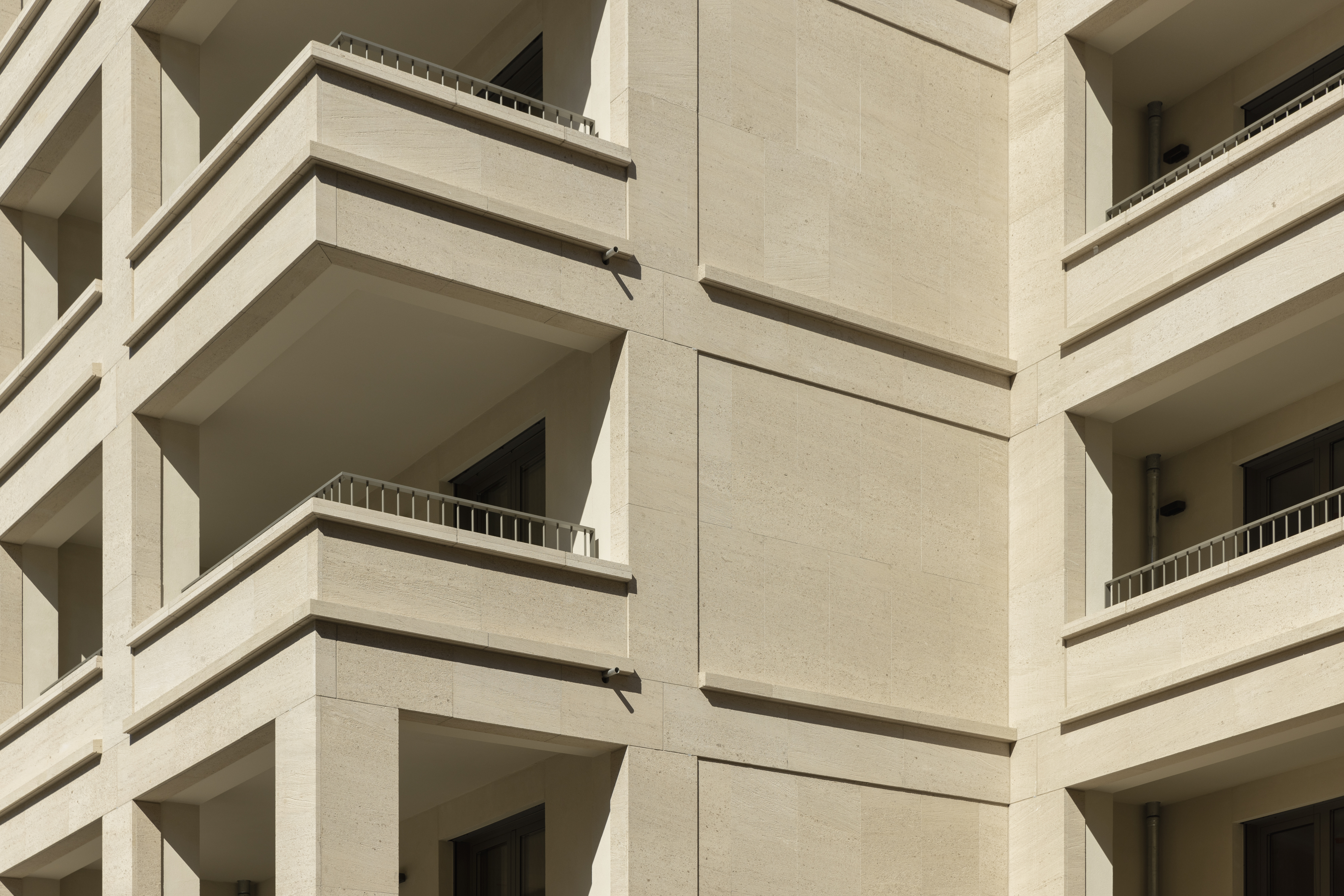The natural stone was used so that its surface qualities and colorfulness are highlighted in the best possible way. The closer you get to the building, the greater is its level of detail.
© HOFMANN NATURSTEIN / Faruk Pinjo
The Renaissance of Natural Stone
Christiane Fath
The natural stone was used so that its surface qualities and colorfulness are highlighted in the best possible way. The closer you get to the building, the greater is its level of detail.
© HOFMANN NATURSTEIN / Faruk Pinjo
Granite, sandstone, limestone, slate or basalt – natural stone has a decisive influence on the character of a building. Yet the most important aspect of this building material, at least from today’s perspective, is probably its ecological value. It is created by natural processes and consumes little energy in its production, i.e. during quarrying and further processing. According to the latest study by the English environmental consultancy Circular Ecology, its CO2 footprint ranks first with only 0.073kg of CO2 emissions per kg of building material, followed by brick (0.24kg) and wood (0.3kg). The building materials commonly used today, cement and steel, perform much worse with 0.95kg and 2.89kg respectively. At the bottom of the list, according to the study, is aluminum, the production of which is extremely energy-intensive, at 12.79kg.
“Besides wood and clay, natural stone is the oldest and at the same time the most sustainable building material on our planet,” says Johannes Georg Hofmann, civil engineer, business economist and managing director of HOFMANN NATURSTEIN in conversation with Prof. Christian Heuchel, O&O Baukunst. The family business has been a leader in the international construction of natural stone façades for over 77 years. “The big topic at the moment, on which many architectural firms ask us to give lectures, is [...] to build with low CO2 emissions in the future and thus to stop climate change [...]. We believe that this has accelerated the return to natural stone,” says Hofmann.
In keeping with this development, O&O Baukunst and HOFMANN NATURSTEIN have collaborated on several projects over the past three decades. The residential and office building at Pariser Platz in Berlin was completed in 2001. In 2018, the architecture firm received a Special Mention at the German Natural Stone Award for the Hainspitze commercial building in Leipzig; and in 2022, the 54-metre-high Schwedler Trio, a residential high-rise in Frankfurt’s up-and-coming Ostend district, was completed as part of a residential ensemble.

The façade of the residential and commercial building on Pariser Platz in Berlin (2001) is clad in light-colored limestone. The façade material is inspired by the material used for the surrounding buildings. © O&O Baukunst / Stefan Müller

The facade of fine-pored, polished Trosselfels shows a clear interpretation of natural stone by means of the vertical and horizontal structure. © O&O Baukunst / Stefan Müller
The concept developed by O&O Baukunst for the new façade on Breslauer Platz at Cologne Central Station also focused strongly on the natural building material. In its design, which the architectural firm proposed as part of a selection process in 2020, O&O Baukunst uses the beige-colored natural stone Pierre de Bordeaux with the Aquapower surface finish for the rear side of the station building. This looks similar to the Drachenfels trachyte used for Cologne Cathedral, thus blending seamlessly into its surroundings. The rear-ventilated façade has a fine texture and is divided into a base (typical of Cologne: made of basalt), a podium with elliptical supports, middle element of cranked, elliptical supports and a final beam as a voute. The natural stone elements, at least 4 cm thick, are milled and invisibly fixed to a steel girder. The façade was to appear transparent, cosmopolitan and generous. Overall, the design demonstrated how modern, sustainable and integrating construction can be achieved through the use of natural stone.

The design for the new facade on Breslauer Platz at Cologne Central Station was created as part of a multiple commission (2021). With the choice of materials, O&O Baukunst Köln related to the existing architecture. The color of the proposed beige natural stone Pierre de Bordeaux is based on the Drachenfels trachyte, which was used for Cologne Cathedral. © O&O Baukunst

The Hainspitze (2016) is a commercial building in Leipzig’s city center. With its detailed natural stone facade, the new building fits seamlessly into the historical structure of the city. © HOFMANN NATURSTEIN / Stefan Müller

The architecture of the surrounding area is characterized by sculpturally designed facades from around 1900. This sculptural effect is taken up in the oblique position of the stone reveals and the glazing. © HOFMANN NATURSTEIN / Stefan Müller
Another sustainable aspect of natural stone is its changeability. As the material is easy to process, various free-form shapes can be produced using the latest technologies such as 5-axis milling and contour rope sawing. Special surface treatments, including high-pressure water jetting, machine cleaving or profiling, offer infinite design possibilities. For the Schwedler Trio project, high-pressure water jetting was used. The diverse processing methods provide architects with numerous ways and means of implementing their designs.
Environmentally conscious planning at an early stage thus makes it possible to design new buildings that can be recycled. Apart from ecological advantages, there is also a human achievement behind every natural stone. Despite the very economical use of ultra-modern machines, the production of natural stone elements is still an artisan process. This gives the material an additional cultural value that becomes part of the city’s history.

The 16-story residential high-rise is part of the Schwedler Trio in the east of Frankfurt’s city center (2022). The natural stone facade made of St. Louis® limestone with the Aquapower surface finish lends the building a lasting quality and emphasizes its striking volume. © HOFMANN NATURSTEIN / Faruk Pinjo
HOFMANN NATURSTEIN GmbH & Co. KG was founded in 1945 and is one of the leading companies in the European natural stone industry with a focus on the construction of natural stone façades. With around 100 major construction projects for renowned architects and clients every year, the company accompanies natural stone façade projects from advising architects and clients, through planning, production and installation, to the completion of the finished natural stone façade. Furthermore, the company has its own quarries and contracted sources with first-class deposits and manufactures exclusively from the natural stone blocks in three company-owned production plants with electricity from renewable energies. The quality of the stone resources is assured by in-house geologists. With its climate-positive production approach, the family-owned company is a pioneer in environmentally friendly and sustainable construction.
Interactive map
Using selected building projects by O&O Baukunst, the topic is presented taking the city of Cologne as an example. For information on the projects, click here for the interactive map.
«Town Planning in Democratic Structures» is a project of O&O Baukunst Köln, C. FATH and World-Architects.






